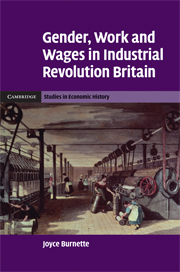Book contents
- Frontmatter
- Contents
- List of figures
- List of tables
- Preface
- Introduction
- 1 Women's occupations
- 2 Women's wages
- 3 Explaining occupational sorting
- 4 Testing for occupational barriers in agriculture
- 5 Barriers to women's employment
- 6 Occupational barriers in self-employment
- 7 Women's labor force participation
- 8 Conclusion
- Appendix to Chapter 3
- Appendix to Chapter 4
- Bibliography
- Index
7 - Women's labor force participation
Published online by Cambridge University Press: 07 August 2009
- Frontmatter
- Contents
- List of figures
- List of tables
- Preface
- Introduction
- 1 Women's occupations
- 2 Women's wages
- 3 Explaining occupational sorting
- 4 Testing for occupational barriers in agriculture
- 5 Barriers to women's employment
- 6 Occupational barriers in self-employment
- 7 Women's labor force participation
- 8 Conclusion
- Appendix to Chapter 3
- Appendix to Chapter 4
- Bibliography
- Index
Summary
Much has been written on the question of whether the Industrial Revolution increased or decreased women's employment opportunities. Friedrich Engels suggested that industrialization emancipated women by providing them with an independent income: “since large-scale industry has transferred the woman from the house to the labor market and the factory, and makes her, often enough, the bread winner of the family, the last remnants of male domination in the proletarian home have lost all foundation.” Engels, however, probably focused too much on factory employment, ignoring employment opportunities that were lost due to industrialization. Eric Richards suggests the opposite, that women's participation in paid work was high in the early eighteenth century and fell substantially with industrialization. More recent literature favors Richards. Davidoff and Hall, for example, emphasize the withdrawal of middle-class women from active involvement in the family business during the first half of the nineteenth century. Andrew August suggests that working-class women in the later nineteenth century did not accept the middle-class notion of separate spheres, and paid work continued to be an accepted part of their lives even when married.
Unfortunately it is difficult to address questions about aggregated employment without reliable aggregate data. Census data are available for the later part of the nineteenth century, and suggest a decline in the participation rate of married women from 25 percent in 1851 to 10 percent in 1901.
- Type
- Chapter
- Information
- Gender, Work and Wages in Industrial Revolution Britain , pp. 306 - 326Publisher: Cambridge University PressPrint publication year: 2008



